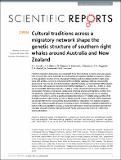Cultural traditions across a migratory network shape the genetic structure of southern right whales around Australia and New Zealand
Abstract
Fidelity to migratory destinations is an important driver of connectivity in marine and avian species. Here we assess the role of maternally directed learning of migratory habitats, or migratory culture, on the population structure of the endangered Australian and New Zealand southern right whale. Using DNA profiles, comprising mitochondrial DNA (mtDNA) haplotypes (500 bp), microsatellite genotypes (17 loci) and sex from 128 individually-identified whales, we find significant differentiation among winter calving grounds based on both mtDNA haplotype (FST = 0.048, ΦST = 0.109, p < 0.01) and microsatellite allele frequencies (FST=0.008, p<0.01), consistent with long-term fidelity to calving areas. However, most genetic comparisons of calving grounds and migratory corridors were not significant, supporting the idea that whales from different calving grounds mix in migratory corridors. Furthermore, we find a significant relationship between δ13C stable isotope profiles of 66 Australian southern right whales, a proxy for feeding ground location, and both mtDNA haplotypes and kinship inferred from microsatellite-based estimators of relatedness. This indicates migratory culture may influence genetic structure on feeding grounds. This fidelity to migratory destinations is likely to influence population recovery, as long-term estimates of historical abundance derived from estimates of genetic diversity indicate the South Pacific calving grounds remain at <10% of pre- whaling abundance.
Citation
Carroll , E L , Baker , C S , Watson , M , Alderman , R , Bannister , J , Gaggiotti , O E , Gröcke , D , Patenaude , N & Harcourt , R 2015 , ' Cultural traditions across a migratory network shape the genetic structure of southern right whales around Australia and New Zealand ' , Scientific Reports , vol. 5 , 16182 . https://doi.org/10.1038/srep16182
Publication
Scientific Reports
Status
Peer reviewed
ISSN
2045-2322Type
Journal article
Description
ELC was supported by the AMMC and a Newton Fellowship from the Royal Society and RH in part by a Sitka Sound Science Centre Scientist in Residency Fellowship. OEG acknowledges support from the MASTS pooling initiative (The Marine Alliance for Science and Technology for Scotland).Collections
Items in the St Andrews Research Repository are protected by copyright, with all rights reserved, unless otherwise indicated.

